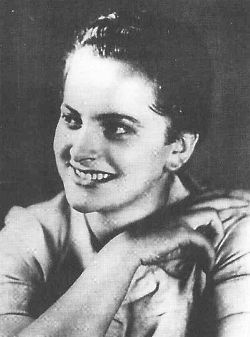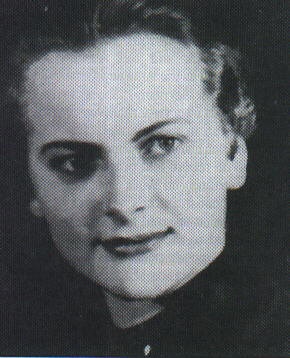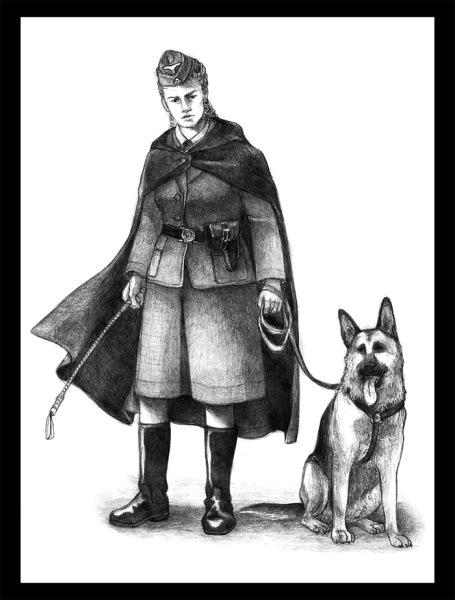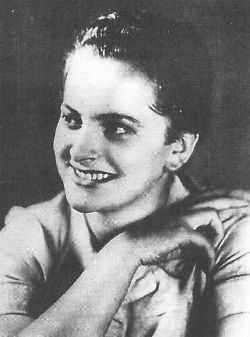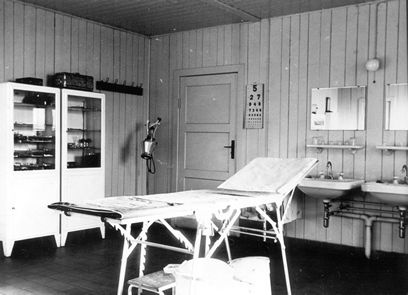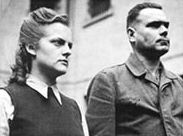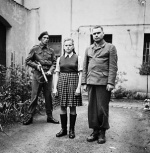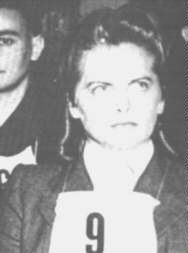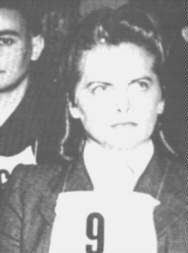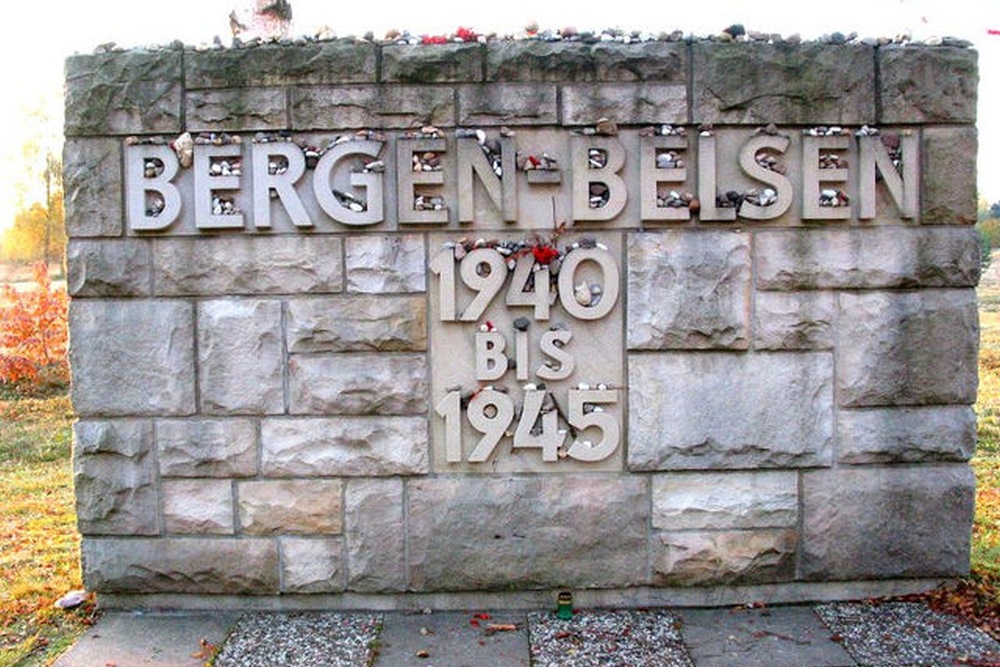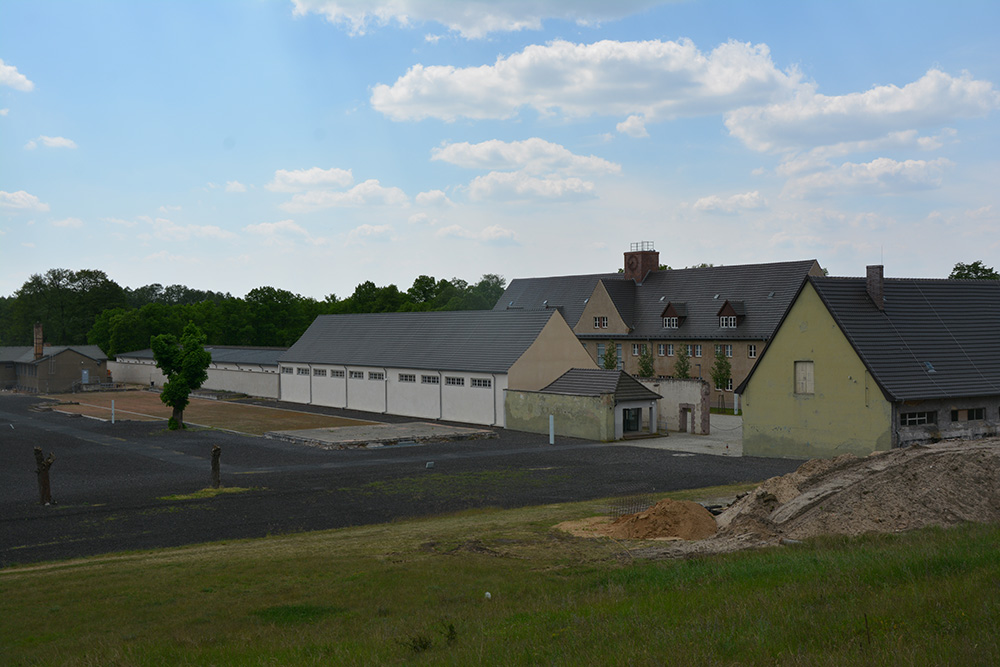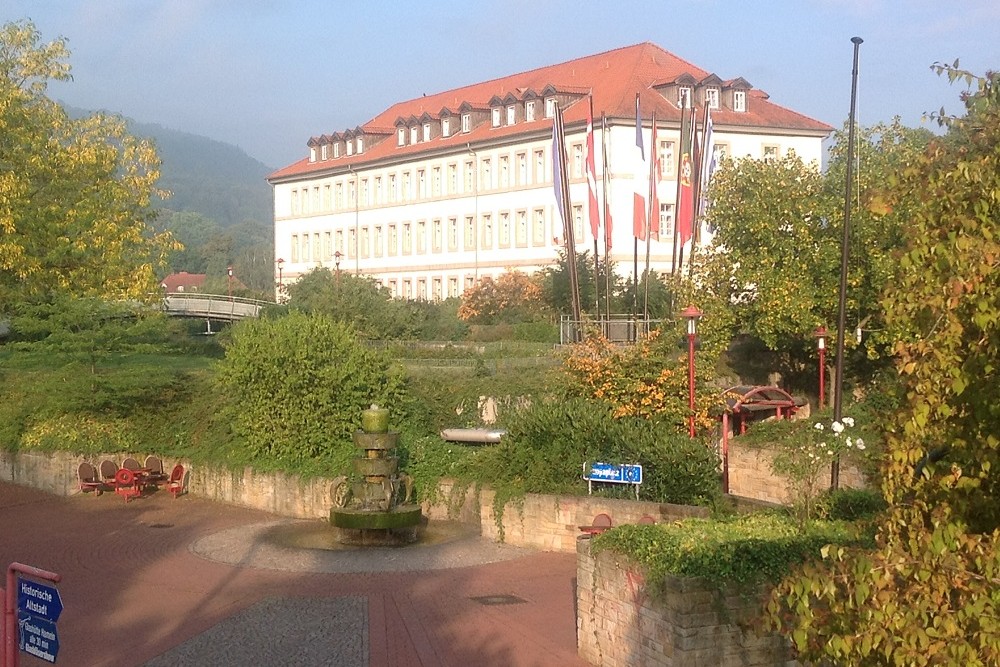Preface
The name of Irma Grese is less well known than that of Rudolph Höss, Josef Kramer or many other names of persons that left their black mark on the history of the Holocaust. Yet she was one of the most infamous female war criminals of that era. She belonged to a relative small group of women that had served in the camps and that were executed by hanging after the war for war crimes. She was the youngest woman to be executed by the British in the 20th century and the youngest camp guard ever to be executed by hanging.
Definitielijst
- Holocaust
- Term for the destruction of European Jewry by the Nazis. Holokauston is the Greek term for a completely burnt sacrifice.
- war crimes
- Crimes committed in wartime. Often concerning crimes committed by soldiers against civilians.
Images
The first years
The little village of Wrechen in the south-east of Mecklenburg is situated in a typical pastoral northern German area. It counted 175 inhabitants when Irma Ilse Ida Grese was born here on 7 October 1923 on a farm. Her father Alfred was a member of the NSDAP since 1937. He earned his living as a dairy worker . His wife Bertha, who had five children with him, committed suicide in 1936. The reason for this remains unclear but marital problems seem to have been at the root of her death.
As Irma Grese grew older she wanted to become a member of the Bund Deutscher Mädel, the BDM, the Nazi youth organisation for girls. However there was no department of the BDM in Wrechen, so Irma would have to travel on bicycle to nearby Fürstenhagen. Her father forbade her this for he considered it to be too dangerous for the young girl. When Irma was 15, in 1938, she left school in Wrechen. The reason for this were poor school grades and bullying by fellow students. She joined the Reichsarbeitsdienst, the RAD. The RAD was a uniformed and military styled Arbeitsdienst or Labour Service for boys and girls. With the RAD Grese completed a so called Landjahr. During the obligatory Landjahr boys and girls were sent to farms all over Germany to help farmers with their daily work. The purpose for this was to learn what hard work meant and to develop "social values". First Irma Grese worked for six months on an estate near Wrechen and later in a dairy farm in the village of Lychen, 40 km distance from Wrechen.
After she finished the Landjahr Grese went to work in a SS sanatorium in Hohenlychen as an assistant nurse. She stayed there for two years and wanted to become a nurse. However she did not succeed in getting an apprenticeship on a nurse school. In 1942 she tried again but to no avail. She was then transferred to a dairy factory in Fürstenberg, in the immediate vicinity of concentration camp Ravensbrück. In July1942, with the aid of an acquainted nurse from Hohenlychen, she tried again to get an apprenticeship. Once again she was turned down
.Definitielijst
- concentration camp
- Closed camp where people are being held captive that are considered to be anti- social, enemies of the state, criminal or unwanted individuals. These groups mostly do not get a fair trial or are condemned to doing time in a camp.
- Nazi
- Abbreviation of a national socialist.
Images
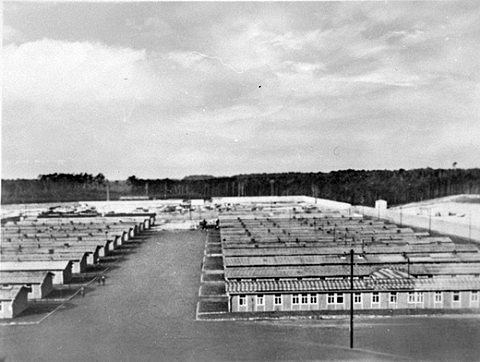 Ravensbrück, Greses field of activity Source: USHMM.
Ravensbrück, Greses field of activity Source: USHMM.The first concentration camp: Ravensbrück
Hereafter and in the same year Grese volunteered for the SS as Helferin, a general term for all female personnel in the SS. The SS Helferinnen ranked lower than all other male personnel within the SS. Women were not acknowledged to be full SS members but only auxiliary personnel, as is implied in the name of their rank. Formally they were not allowed to give orders to male personnel. Nonetheless, the training for female camp guards was much like the training for their male guard counterparts. The women followed courses that ranged in length from one to six months. The courses were taught by female head guards. The students were taught how to punish prisoners and how to perceive sabotage and other undermining activities within the camp. They were also taught how to humiliate and abuse female prisoners. After completing the course one was an official Aufseherin or supervisor. With Aufseherin a normal guard was meant, it was the lowest rank among the guards. After this one could continue and become a Erstaufseherin (prime supervisor), Rapportführerin (report leader), Oberaufseherin ( senior supervisor) and Lagerführerin(camp leader). The highest rank for female personnel was Chef Oberaufseherin, a rank that only two women ever held. One was Luise Brunner in Auschwitz-Birkenau and the other was Anna Klein in Ravensbrück.
The Ravensbrück concentration camp lay 90 km north of Berlin and was opened in May 1939. It was specifically designed for female prisoners. It also functioned as a training centre for camp guards. Until 1945 a total of 3,500 Aufseherinnen were trained there. Irma Grese was also trained in Ravensbrück. During her post war interrogation Grese stated that she was sent to this camp by the labour office and that this was not of her own choice. The truth about this is contested. Being only 18 years old Grese received a wage of only 54 Reichsmark, much less than the wages of the other guards. Grese was trained by the infamous Dorothea Binz who spent her entire career with the SS at Ravensbrück. She was the chief trainer and shared with Grese a preference for bizarre and sadistic practices when torturing female prisoners.
Before being allowed to work as a guard in the camp Grese had to participate in so-called Aussenkommandos, literally "outside squads", groups of prisoners who had to work outside the actual camps. A survivor remembers: Each squad had its own Aufseherin. I got to know Irma Grese in the Kräuter-Kommando (weeds-squad). There we picked nettles and our hands were bleeding because we did not get gloves. She gave us very high baskets and she stamped in the baskets with her boots. If the baskets were not filled up she would beat us on the head left and right. Irma Grese was very beautiful. And she was extremely evil.
During her stay at Ravensbrück Grese regularly visited her family in Wrechen. These visits led to heavy quarrels with her father, who was supposedly against her work in the camps. In the end he forbade her to set foot in his home again.
Definitielijst
- Auschwitz-Birkenau
- The largest German concentration camp, located in Poland. Liberated on 26 January 1945. An estimated 1,1 million people, mainly Jews, perished here mainly in the gas chambers.
- concentration camp
- Closed camp where people are being held captive that are considered to be anti- social, enemies of the state, criminal or unwanted individuals. These groups mostly do not get a fair trial or are condemned to doing time in a camp.
Images
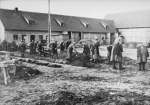 A 'Arbeitskommando' (working squad) in Ravensbrück. Source: USHMM.
A 'Arbeitskommando' (working squad) in Ravensbrück. Source: USHMM.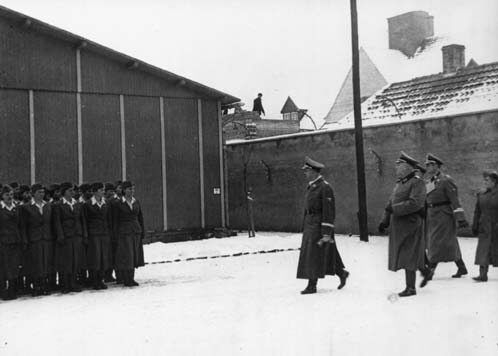 Heinrich Himmler inspecting supervisors in Ravenbrück. Source: Ravensbrueck.de.
Heinrich Himmler inspecting supervisors in Ravenbrück. Source: Ravensbrueck.de.The second concentration camp: Auschwitz-Birkenau
In March 1943, Irma Grese was transferred to Auschwitz-Birkenau where she would earn the nicknames "beautiful beastess", "blond angel of death", "blond angel from hell" and "hyena of Auschwitz". As at Ravensbrück she would start her work at Aussenkommandos. After having worked briefly as a post censor, she was promoted on instigation of her direct superior Maria Mandel to head of sector BIIc, which was also known as the C-Lager or C-camp. In the meantime she was promoted to the rank of Oberaufseherin, the second highest rank a woman could get in a camp. In the beginning this camp was inhabited by Jewish women from Poland and later from Hungary. From the summer of 1944 onwards 20,000 to 30,000 women would be incarcerated here under appalling conditions, exposed to the mercy of Irma Grese.
Her good looks with large blue eyes and long blond hair were noticed even by the inmates, as is testified by several survivors. According to them , Grese could stand in front of mirrors for hours and would have a tailor make dresses for her all the time. She dreamt of becoming a film star after the war. Testimonies exist that suggest that she had nymphomaniac traits, that she sexually abused male and female prisoners and that she slept with several SS doctors among whom Joseph Mengele. Grese had one pregnancy, father unknown, aborted by Giselle Perl, a Hungarian Jewish doctor who was imprisoned in Auschwitz. Perl declared after the war that Grese would watch along regularly when she examined women and that Grese became sexually aroused when she saw that these women were in pain.
Irma Grese also had sexual relationships with female prisoners. Two of them are known by name. There was a young woman called Magda with whom Grese had a bizarre friendship. Despite the fact that their respective status in the camp could not be compared, Grese used her to talk with her about her frustrations. When she searched sexual pleasure with women but was refused by them, she would go to Magda to vent her feelings. Magda would function as a look out post when she sexually abused others. The second person was Nina. Grese had heard that there was an inmate that looked like her. After she found her, Nina would fulfil the same role as Magda. In exchange Nina would receive extra food and the attention of Grese herself.
As already mentioned the conditions in the Auschwitz-Birkenau women camp were appalling beyond description. Tens of thousands of inmates were cramped into 62 barracks, virtually without drinking water and plagued by diseases as tuberculosis, typhus and dysentery . This was the environment where Irma Grese spread death and destruction. Not only was Irma beautiful, she was also infamous for her limitless cruelty and capricious nature. In her position Grese held power over tens of thousands and she had the power to destroy hundreds whenever she wanted to. During the post war trial many survivors testified in detail to murders, abuses and sexual excesses by Grese in Auschwitz. She also participated in the selections by SS doctor Mengele, was responsible for around 30 murders a day, beat prisoners continuously ,let loose her starving dogs at prisoners and abused prisoners for her sadistic bisexual pleasures.
A selection of these crimes:
The sisters Ackermann from the Hungarian Ungvàr experienced Grese during the roll calls that lasted for hours on a row. The Rapportführerin – called Grese – had a rubber baton, and would beat you up if you did not stand erect.
A similar reminiscence by a house wife from the Hungarian Huszt who turned out in Block 16 of the C-Lager: Roll call started already early in the morning and was repeated several times during the day. We were beaten for all possible and impossible reasons. If a woman called Grese came we had to stay on our knees sometimes even for eight hours and to keep heavy stones above our heads.
During the selections Irma Grese, together with her colleague Margot Drechsler and SS doctor Mengele, decided between life and death. A former prisoner remembers: These two women were even crueller than Mengele ... Selections happened the following way: First, naked women scuffled in front of Mengele with arms raised; and then in front of Grese and Drechsler. Mengele did the first selections, while the women might select also people who Mengele left unselected."
During the post war trial survivor Ilona Stein testified about Grese as follows: Whilst at Birkenau I have seen Grese making selections with Dr Mengele of people to be sent to the gas chamber. On these parades Grese herself chose the people to be killed in this way. In one selection about August 1944, there were between 2,000 and 3,000 selected. At this selection Grese and Mengele were responsible for selecting those for the gas chamber.People chosen would sometimes sneak away from the line and hide themselves under their beds. Grese would go and find them, beat them until they collapsed and then drag them back into line again. I have seen everything I describe. It was general knowledge in this camp that persons selected in this way went to the gas chambers.
There are testimonies that prove without any doubt that Irma Grese was a sadist. Without any other incentive she would whip pretty women in the face to destroy their good looks. According to a survivor once Grese gouged out the eyes of an unfortunate prisoner because she had talked to another prisoner through the barbed wire fence. Sometimes Irma Grese would assist the SS doctors while conducting medical experiments. She was said to have a preference for operations where breasts were amputated.
A testimony of survivor Vera Alexander: She shot one woman dead who was standing in front of me. Her brains landed on my shoulder. The next day, after the selections, Irma came to see me. I refused to talk to her. She asked, 'Are you angry with me?' I replied, 'You nearly killed me yesterday'. She answered: 'One down, it doesn't matter…'"
Definitielijst
- Auschwitz-Birkenau
- The largest German concentration camp, located in Poland. Liberated on 26 January 1945. An estimated 1,1 million people, mainly Jews, perished here mainly in the gas chambers.
Images
Return to Ravensbrück and the end at Bergen- Belsen
When the Germans evacuated Auschwitz before the rapidly advancing Red Army, Grese was sent to Ravensbrück with a prisoner transport on 18 January 1945.Her stay there would be a short one because the camp had to be evacuated in the beginning of March. Grese left with a transport of female prisoners to Bergen-Belsen. There she would work another two months as Arbeitsdienstführerin (Labour Service Leader)under camp commander Josef Kramer, with whom she is supposed to have had an affair as well.
The population of the camp of Bergen-Belsen had risen to many tens of thousands (ultimately near 90,000) during the period that Grese arrived there. It had become a collection camp for prisoners that had been evacuated from Auschwitz, Buchenwald and Ravensbrück. The overpopulated camp was on top of that struck by an epidemic of typhus due to the abominable conditions in the camp. The situation became more and more untenable and the arrival of British troops was in all aspects a relief for the prisoners. Many would die even after being liberated due to the prolonged exposure to abuse, malnutrition, lack of shelter etcetera.
On 15 April 1945, Irma Grese was captured by the British together with Josef Kramer and SS guards who remained in the camp. During the following days they were forced to help bury the thousands of deceased prisoners into mass graves. Finally Grese was transferred to the prison of Celle near Lüneburg (Lower Saxony) awaiting her trial.
Definitielijst
- Red Army
- Army of the Soviet Union.
Images
The trial
Originally the trial was supposed to take place in August 1944 due to heavy international pressure but that was not possible at this short notice. From 17 September to 17 November 1945, under great public interest, the trial was held in a former gymnastics hall at the Lindenstrasse in Lüneburg. A British military court handled the so called Belsen-trial. The official name of the trial was "Trial against Josef Kramer and 44 others". The court consisted of six judges among whom Major general Berney-Ficklin as president. Field marshall Bernard Montgomery was to be the instance of appeal. The four prosecutors and the advocates of the Germans were also British officers. The court language was English and translators would communicate from English to German, Hungarian and Polish. This took a vast amount of time and this was the main reason that the trial took much longer than the one or two weeks originally intended.
Because some defendants had been active at Bergen-Belsen as well as Auschwitz, this trial can be considered the first Auschwitz trial. Because some defendants had been active at both camps there were two categories of charges. Against all defendants for war crimes committed at Bergen-Belsen and against 11 defendants (among whom Irma Grese) for war crimes committed in Auschwitz. The murder of individuals was not investigated, because just the size of this would have resulted in an unworkable situation. British military law was applied. The official charge was violation of the Geneva Convention by committing war crimes. Irma Grese was defended by the British Major L.S.W.Cranfield.
Many survivors of Ravensbrück, Auschwitz and Bergen-Belsen testified against Grese. They spoke in detail about her behaviour in the camps and the terror and fright that struck them whenever they saw her. Irma Grese pleaded not guilty of the charges that were filed against her: abuse and murder of defenceless prisoners, including unleashing dogs at them and repeated beatings. For her defence she stated that she had only followed orders. She declared: "Himmler is ultimately responsible for all that happened, but I assume that I bear as much responsibility as my commanding officers". She denied vehemently the charges that were brought up against her. She declared that she saw the prisoners as sub human "Dreck" (mud or filth) and that she did not see anything wrong in her actions during the war. Her actions had been nothing more than necessary and she declared that she always had abided by the rules.
In his plea Major Cranfield mentioned that Irma Grese had become motherless at the age of 14 and was raised in poverty. Because of her low social standing she had not received a fair amount of education which made her more susceptible to Nazi indoctrination. Besides that she was forced to work in the camps as a guard while she really wanted to have become a nurse. This was actually not true. The core of Cranfield’s plea was that Nazism and not Irma Grese, was responsible for the crimes that happened in the camps.
In October 1945 survivor Batsheva Dagan wrote an open letter to Irma Grese. A passage reads: Now it is our turn to hate you and to cry out for revenge. "Achtung, Frau Aufseherin Grese kommt!" (Attention! Warder Grese’s coming). I shall never forget the terror that this command struck in our hearts. I shall remember you as you strutted through the camp in your SS uniform, that enormous dog by your side which you used to love to set on us "just for fun." I shall always remember your gleaming and elegant jackboots, and the way you kicked us with them.
On the fifty fourth day of the trial, on 17 November 1945, Irma Grese was found guilty of all charges and was sentenced to death by hanging for her crimes committed at Auschwitz and Bergen-Belsen. During the entire trial she had showed very few emotions. She seemed unmoved when she heard the verdict. Her request for pardon was immediately turned down by Montgomery. Appeal against this was not possible.
Definitielijst
- indoctrination
- The education or brainwashing of people, sometimes by force, to accept a certain opinion or political doctrine. This doctrine is to be followed henceforth without question.
- Nazi
- Abbreviation of a national socialist.
- Nazism
- Abbreviation of national socialism.
- war crimes
- Crimes committed in wartime. Often concerning crimes committed by soldiers against civilians.
Images
The execution
Upon completion of the trial Irma Grese was transferred to the prison of Hameln in Westphalia to await her execution. A room for the execution was constructed inside the prison by the Royal Engineers of the Royal Army. The gallows was constructed at the end of a small corridor where those who were sentenced to death were incarcerated in small cells. Because the prisoners in the cells could hear the trapdoor from the gallows at every execution. It was decided to hang Grese first considering her age.
For the execution a special civilian hangman was flown in from Great Britain, the notorious Albert Pierrepoint, who at that time already had executed 400 convicted criminals. On 12 December 1945 the convicted were weighed and measured so that the hangman could calculate the necessary adjustments for the gallows for the execution the next day. Pierrepoint described the execution and what came before that as follows:
The day before the execution:
RSM O'Neil ordered 'bring out Irma Grese'. She walked out of her cell and came towards us laughing. She seemed as bonny a girl as one could ever wish to meet. She answered O'Neil's questions, but when he asked her age she paused and smiled. I found that we were both smiling with her, as if we realised the conventional embarrassment of a woman revealing her age. Eventually she said 'twenty-one,' which we knew to be correct. (In fact at that moment her age was 22). O'Neil asked her to step on to the scales.
The day of the execution:
"The following morning we climbed the stairs to the cells where the condemned were waiting. A German officer at the door leading to the corridor flung open the door and we filed past the row of faces and into the execution chamber. The officers stood at attention. Brigadier Paton-Walsh stood with his wristwatch raised. He gave me the signal, and a sigh of released breath was audible in the chamber, I walked into the corridor. 'Irma Grese,' I called. The German guards quickly closed all grills on twelve of the inspection holes and opened one door. Irma Grese stepped out. The cell was far too small for me to go inside, and I had to pinion her in the corridor. 'Follow me,' I said in English, and O'Neil repeated the order in German. At 9.34 a.m. she walked into the execution chamber, gazed for a moment at the officials standing round it, then walked on to the centre of the trap, where I had made a chalk mark. She stood on this mark very firmly, and as I placed the white cap over her hand she said in her languid voice 'Schnell'. The drop crashed down, and the doctor followed me into the pit and pronounced her dead. After twenty minutes the body was taken down and placed in a coffin ready for burial."
Irma Grese was buried immediately after her execution at the yard of the prison. In 1954 she was reinterred at the cemetery am Wehl in Hameln. In 1986 her grave was emptied after it had become a site of pilgrimage for right wing radical groups.
Information
- Article by:
- Robert Jan Noks
- Translated by:
- Peter ter Haar
- Published on:
- 19-01-2025
- Feedback?
- Send it!
Related sights
Sources
- www.pbs.org/auschwitz
- Verzet.org
- www.leninimports.com/irma_grese.html
- www.ravensbrueck.de
- max.mmvi.de/ssfrauen/irmagrese.htm
- www.bis.uni-oldenburg.de
- www.geocities.com/CapitolHill/6142/irma.html
- www.degob.hu
- www.scrapbookpages.com/BergenBelsen
- www.ndr1radiomv.de
- www.zwoje-scrolls.com
- www.webster.edu
- www.ess.uwe.ac.uk
- www.aldridgeshs.qld.edu.au
- max.mmvi.de/ssfrauen/dorotheabinz.htm
- en.allexperts.com/e/i/ir/irma_grese.htm
- www.experiencefestival.com/irma_grese
- www.stephen-stratford.co.uk/belsen_trial.htm
- www.oakton.edu/user/
- en.wikipedia.org/wiki/Aufseherin
